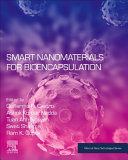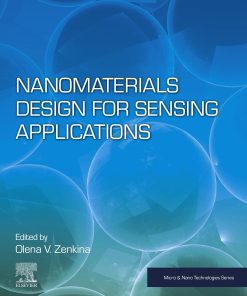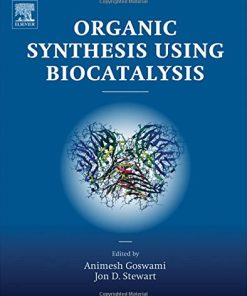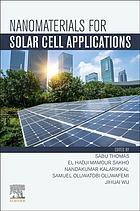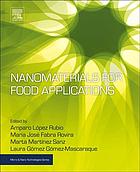Nanomaterials for Biocatalysis 1st edition by Guillermo Castro 0128244371 9780128244371
$50.00 Original price was: $50.00.$25.00Current price is: $25.00.
Nanomaterials for Biocatalysis 1st edition by Guillermo R. Castro – Ebook PDF Instant Download/DeliveryISBN: 0128244371, 9780128244371
Full download Nanomaterials for Biocatalysis 1st edition after payment.
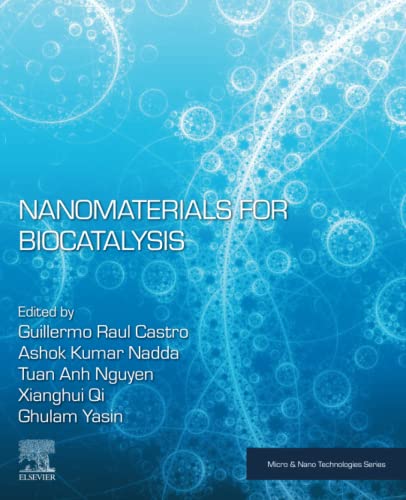
Product details:
ISBN-10 : 0128244371
ISBN-13 : 9780128244371
Author: Guillermo Castro
Nanomaterials for Biocatalysis explains the fundamental design concepts and emerging applications of nanoscale biocatalysts, such as bioconversions, bioelectronics, biosensors, biocomputing and therapeutic applications. Nano-biocatalysts refers to the incorporation of enzymes into nanomaterials. These enzyme-enhanced nanocarriers have many advantages, including low mass transfer limitation, high enzyme capacity, better stabilization, and the formation of single-enzyme nanoparticles. Smart nanocontainers have been developed for the smart release of their embedded active substances. These smart releases can be obtained by using smart coatings as their outer nanoshells.
In addition, these nanocontainers could protect the enzymes from chemical or metabolic alterations on their delivering pathways towards the target. This is an important reference source for materials scientists and chemical engineers who want to know more about how nanomaterials are being used for biocatalysis applications.
Nanomaterials for Biocatalysis 1st Table of contents:
Section 1: Basic Principles
Chapter 1. Nanobiocatalysis: an introduction
Abstract
1.1 Introduction
1.2 Metallic nanomaterials
1.3 Carbonaceous nanomaterial
1.4 Other nanomaterials
1.5 Conclusion
Acknowledgment
References
Chapter 2. Enzyme immobilized nanomaterials
Abstract
2.1 Introduction
2.2 Components of the “nano-enzyme conjugates”
2.3 Enzymes immobilized on nanomaterials
2.4 Characterization of enzyme-nano conjugates
2.5 Applications of nano-enzyme bioconjugates
2.6 Conclusions and future perspectives
Acknowledgments
References
Chapter 3. Electrochemical functionalization of carbon nanomaterials and their application in immobilization of enzymes
Abstract
3.1 Introduction
3.2 Methods of enzyme immobilization
3.3 Nanostructured carbon materials
3.4 Functionalization of nanostructured carbon materials for bioelectrocatalysis applications
3.5 Some selected examples of electrochemical functionalization and enzyme immobilization
3.6 Conclusions
Acknowledgment
References
Chapter 4. Mechanisms of interaction among enzymes and supports
Abstract
4.1 Introduction
4.2 Fundamental aspects of protein structure for enzyme-support interaction
4.3 Porous materials as effective enzyme supports
4.4 Characterization of immobilized enzymes
4.5 Conclusions
References
Chapter 5. The impact of nanoparticles-based enzyme immobilization in biocatalysis
Abstract
5.1 Introduction
5.2 Magnetic nanoparticles
5.3 Characteristic properties of magnetic nanoparticles
5.4 Structural chemistry of magnetic nanoparticles
5.5 Functionalization and stabilization of magnetic nanoparticles
5.6 Biocatalysis via enzyme immobilization on nanostructures
5.7 Applications of nanoparticles in enzyme technology and their industrial relevance
5.8 Conclusion and future directions
Acknowledgments
Conflict of interest
References
Further reading
Section 2: Nanomaterials in Biocatalysts
Chapter 6. Silica-based nanomaterials in biocatalysis
Abstract
6.1 Catalytic reactions and biocatalysts
6.2 Conclusion
Acknowledgments
Declaration of interests
References
Chapter 7. Enzyme-metal nanobiohybrids in chemobiocatalytic cascade processes
Abstract
7.1 Introduction
7.2 Synthesis of enzyme–metal hybrid catalysts
7.3 Classification of enzyme–metal hybrid catalysts (E-MNPs) by metal nano particles
7.4 Application of enzyme-metal nanoparticle hybrid catalysts in cascade reactions
7.5 Conclusion
Acknowledgments
References
Chapter 8. Nanostructured organic supports
Abstract
8.1 Introduction
8.2 Polymeric nanofibers
8.3 Polymeric nanoparticles
8.4 Polymeric nanogels
8.5 Polymeric micelles
8.6 Inorganic-organic hybrid nanostructures
8.7 Conclusion
References
Chapter 9. Recent developments of iron-based nanosystems as enzyme-mimicking surrogates of interest in tumor microenvironment treatment
Abstract
9.1 Introduction
9.2 Biocatalytic activity of FexOy nanomaterials
9.3 Role of Fe-based nanoparticles in tumor cell microenvironments: interaction with hydrogen peroxide and glutathione
9.4 New trends in nanozyme materials: single atom catalysts
9.5 Conclusions and outlook
References
Chapter 10. Metal organic frameworks for biocatalysis
Abstract
10.1 Introduction
10.2 Synthesis of enzyme-metal-organic frameworks composites
10.3 Application of enzyme-metal-organic frameworks composites
10.4 Summary and outlook
References
Chapter 11. Enzyme immobilization on magnetic nanoparticle supports for enhanced separation and recycling of catalysts
Abstract
11.1 Introduction
11.2 Magnetic support materials for enzyme immobilization
11.3 Immobilization methods on magnetic supports
11.4 Single enzyme systems
11.5 Multi-enzyme cascade systems
11.6 Cofactor-dependent systems
11.7 Conclusion and future outlooks
References
Chapter 12. Polymers and metal−organic frameworks as supports in biocatalysis: applications and future trend
Abstract
12.1 Introduction to biocatalysis
12.2 Enzyme immobilization on polymers, biopolymers, and metal−organic frameworks
12.3 Applications of immobilized biocatalyst
12.4 Limitations and challenges in the application of organic materials as enzyme supports
References
Chapter 13. Carbon nanotubes/nanorods in biocatalysis
Abstract
13.1 Introduction
13.2 Carbon nanotubes in biocatalysis
13.3 Multi-walled carbon nanotubes in biocatalysis
13.4 Non-covalent immobilization of enzymes on multi-walled carbon nanotubes
13.5 Covalent immobilization of enzymes on multi-walled carbon nanotubes
13.6 Single-walled carbon nanotubes in biocatalysis
13.7 Hybrid materials based on carbon nanotubes in biocatalysis
13.8 Other carbon nanoshapes in biocatalysis
13.9 Conclusions
Acknowledgment
References
Chapter 14. Gold nanoparticles for biocatalysis
Abstract
14.1 Introduction
14.2 Gold as catalyst for chemical and biochemical reactions
14.3 Gold as support of biocatalytic compounds (enzymes)
14.4 Synthesis approaches of gold nanoparticles
14.5 Advanced techniques for the characterization of gold nanoparticles used as enzymes support
Acknowledgments
References
Section 3: Emerging Applications
Chapter 15. Nanobiocatalyst for drug delivery
Abstract
15.1 Introduction
15.2 Therapeutic enzymes
15.3 Strategies for therapeutic enzyme delivery
15.4 Nanocarriers for biocatalysis
15.5 Conclusions and future prospects
Acknowledgments
References
Chapter 16. Enzymatic biosensors for the detection of water pollutants
Abstract
16.1 Introduction
16.2 Aacetylcholinesterase-based biosensors
16.3 Electrochemical biosensors
16.4 Optical biosensors
16.5 Polyphenol oxidases-based biosensors
16.6 Biosensors based on zinc-oxide nanoparticles
16.7 Biosensors based on gold nanoparticles
16.8 Biosensor based on α-Fe2O3 nanocrystals
16.9 Biosensors based on polypyrrole nanotubes
16.10 Biosensors based on carbon nanomaterials
16.11 Biosensor based on poly(3,4-ethylenedioxythiophene)-iridium oxide
16.12 Peroxidase-based biosensors
16.13 General characteristics of peroxidases
16.14 Nanomaterial-peroxidase-based biosensors
16.15 Biosensors for H2O2 detection
16.16 Biosensors for phenolic and amine compounds detection
16.17 Biosensors for pesticides detection
16.18 Conclusion
References
Chapter 17. Biocatalytic nanomaterials as an alternative to peroxidase enzymes
Abstract
17.1 Introduction
17.2 Overview of peroxidase enzyme
17.3 Peroxidase-like activity of nanoparticles
17.4 Applications of biocatalytic nanomaterials with peroxidase-like activity
17.5 Future perspective
17.6 Conclusion
References
Chapter 18. Lignin peroxidase–a robust tool for biocatalysis
Abstract
18.1 Introduction
18.2 Ligninolytic system of white-rot fungi
18.3 Lignocellulosic wastes
18.4 Production, purification, and characterization of lignin peroxidase
18.5 Enzyme immobilization–advantages and disadvantages
18.6 Selection of best immobilization carrier
18.7 Methods for enzyme immobilization
18.8 Selection of appropriate immobilization method
18.9 Natural polymers for enzyme immobilization
18.10 Synthetic polymers as supports for enzyme immobilization
18.11 Industrial applications of lignin peroxidase
18.12 Conclusion and future perspectives
18.13 Competing interests
References
Chapter 19. Laccases: catalytic and functional attributes for robust biocatalysis
Abstract
19.1 Introduction
19.2 Laccase and their general properties
19.3 Laccase structure and active site
19.4 Catalytic mechanism of laccase
19.5 Difference of laccase with other oxidases
19.6 Laccase substrates and inhibitors
19.7 Occurrence of laccase
19.8 Production of laccase
19.9 Purification and characterization of laccase
19.10 Immobilization of laccase
19.11 Environmental bioremediation by laccase
19.12 Conclusion and directions
References
Further reading
Chapter 20. Microbial exo-polygalacturonase—a versatile enzyme with multiindustrial applications
Abstract
20.1 Pectinases
20.2 Substrate for pectinase enzymes
20.3 History of pectinases
20.4 Sources of pectinases
20.5 Structural topology of pectinase
20.6 Modern classification of pectinases
20.7 Production of exo-polygalacturonase
20.8 Biochemical characterization
20.9 Industrial applications of pectinases
Acknowledgments
Declaration of interests
References
Chapter 21. Therapeutic applications
Abstract
21.1 Introduction
21.2 Enzyme-immobilized nanomaterials
21.3 Nanomaterials displaying enzyme-like activities
21.4 Multifunctional nanozymes
21.5 Single-atom catalysts
21.6 New nanodevices for therapy: nanomotors based on gated enzyme-powered Janus nanoparticles
21.7 Concluding remarks
Acknowledgments
References
Chapter 22. Nanosupport immobilized β-galactosidases, their stabilization, and applications
Abstract
22.1 Introduction
22.2 Sources of β-galactosidase
22.3 Immobilization of enzymes
22.4 Applications of nanoimmobilized β-galactosidase
22.5 Conclusion and future outlook
Acknowledgments
References
Chapter 23. Nanocarbon for bioelectronics and biosensing
Abstract
23.1 Introduction
23.2 Properties and biocompatibility of nanocarbon
23.3 Nanocarbon for bioelectronic applications
23.4 Soft nanocarbon bioelectronics for precision therapy
23.5 Nanocarbon bioelectronics for tissue engineering
23.6 Carbon nanotubes-based nanoelectronics for tissue engineering
23.7 Applications of nanocarbon-based biosensors
23.8 Skin temperature monitoring
23.9 Broad range human body movement monitoring
23.10 Electrochemical biosensor
23.11 Conclusion
People also search for Nanomaterials for Biocatalysis 1st:
nanotechnology for biomedical applications
nanotechnology for breast cancer
epa nanomaterials
fluorescent nanoparticles for bioimaging
journal of nanotechnology and nanomaterials impact factor
Tags: Nanomaterials, Biocatalysis, Guillermo Castro, Biocatalysis explains
You may also like…
Uncategorized
Chemistry - Organic Chemistry
Technique - Energy: Renewable Energy
Biology and other natural sciences - Biology
Marine Biology 10th Edition by Peter Castro, Michael Huber 0078023068 978-0078023064
Engineering




